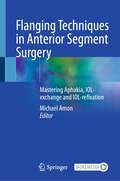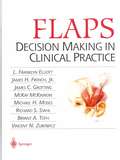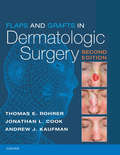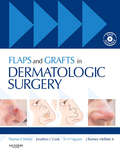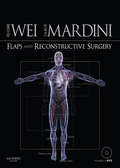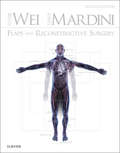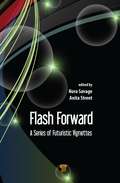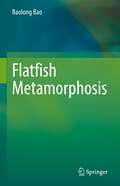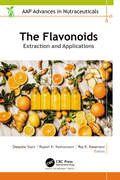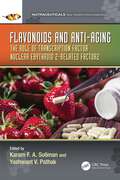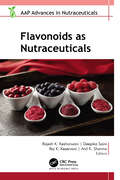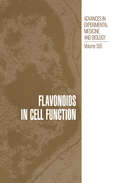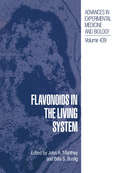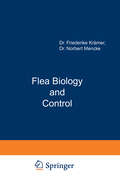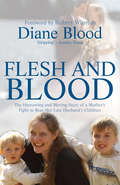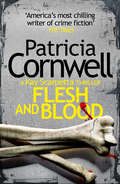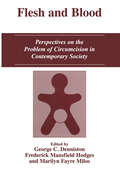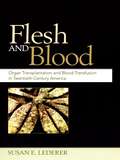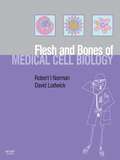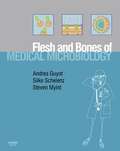- Table View
- List View
Flanging Techniques in Anterior Segment Surgery: Mastering Aphakia, IOL-exchange and IOL-refixation
by Michael AmonThis book highlights the great achievements made in order to overcome challenging situations with different flanging techniques. Liliana Werner will discuss the different causes of IOL luxation. Shin Yamane, Sergio Canabrava, Gabor Scharioth and Ehud Assia will describe their disruptive techniques for scleral IOL fixation.Even though it is impossible to describe and discuss the plethora of surgical techniques, implants and instruments completely, we also tried to create a systematic approach for decision making and give an overview on instrumentation.As flanging techniques represent a very demanding surgery, the aim of this book is to steepen the learning curve and to encourage surgeons to add the presented techniques to their surgical armamentarium.
FLAPS: Decision Making in Clinical Practice
by L. Franklyn Elliot James H. French James C. Grotting McKay McKinnon Michael H. Moses Richard S. Stahl Bryant A. Toth Vincent N. ZubowiczFlaps: Decision Making in Clinical Practice is an excellent readable guide for surgeons utilizing multiple techniques in plastic and reconstructive surgery. The authors have organized a pragmatic guide, specifically focused on those flaps which surgeons find difficult and challenging, with the latest technical developments in all anatomical areas.
Flaps and Grafts in Dermatologic Surgery E-Book
by Thomas E. Rohrer Jonathan L. Cook Andrew KaufmanAchieve optimal results in reconstructive surgery involving flaps and grafts with this up-to-date reference written by leading dermatologic surgeons. Using a systematic approach, Flaps and Grafts in Dermatologic Surgery, Second Edition, by Drs. Thomas E. Rohrer, Jonathan L. Cook, and Andrew J. Kaufman, offers practical, easily accessible guidance in this challenging area, including anatomical considerations, the delicate nature of tissue movement, principles of aesthetic surgical closures, relevant tissue biomechanics, and much more. Covering everything from the basic linear and arciform closures, to the more challenging V-Y advancement flaps, and complex staged interpolation flaps, this text clearly presents not just the "how to do it" but more importantly the thought processes behind the selection and execution of each reconstructive procedure.Describes which flap or graft to choose in specific clinical situations, how to execute each repair (with a multitude of images and diagrams), and how to minimize the risks as well as manage potential complications.Provides algorithms to assist with flap and graft choices, as well as hundreds of superb full-color illustrations throughout.Includes an all-new chapter on Surgical Complications and Scar Revisions. Includes access to high-quality videos showing exactly how the flap/graft is incised, moved, and sutured. New videos include the Rhomboid Transposition Flap for Defect on the Lower Lid, the Island Pedicle Flap with Canthal Suspension, and the Primary Lid Repair with Diagonal Tarsal Suture Sine Marginal Sutures.
Flaps and Grafts in Dermatologic Surgery E-Book
by Thomas E. Rohrer Jonathan L. Cook Tri H. NguyenAuthored by experts in the field, this brand-new reference presents a systematic approach to which flap or graft to use in which clinical situation and how to cut and move the skin. More than 350 full-color photographs and line drawings offer you step-by-step guidance and demonstrates reconstructive procedures, including cutting, positioning, and suturing of flaps and grafts.Includes numerous reconstructive options for each specific region of the face, and explains why one may be better than another in a given situation. Features several chapters on the use of flaps and grafts in facial reconstruction and describes the finer points of their design, execution, and application. Discusses complications and pitfalls and how to avoid them. Devotes an entire chapter to facial anatomy with an emphasis on practical landmarks and danger areas. Uses a consistent format throughout for ease of reference.
Flaps and Reconstructive Surgery E-Book
by Fu-Chan Wei Samir MardiniFlaps and Reconstructive Surgery, by Drs. Fu-Chan Wei and Samir Mardini, explains how to achieve excellent results while performing all major conventional and perforator flaps used as both pedicled and free flap procedures. Respected microsurgeons from around the world describe how to use these flaps to reconstruct particular defects around the body. Videos demonstrate the entire spectrum of surgical reconstructive procedures and flaps, while high-quality illustrations, clear photographs and detailed case studies provide examples to help you achieve best possible outcomes. See how to make optimal use of perforator flaps for reconstruction of the mandible, maxilla, forehead, lower extremity … pedicled flaps for reconstruction of shoulder motion in brachial plexus palsy … anterolateral thigh flaps for reconstruction of defects in the head and neck, upper extremity, and lower extremity … temporoparietal fascia flap for ear reconstruction … nerve grafts for obstetric brachial plexus palsy reconstruction ... groin flaps for hand reconstruction ... harvest of the trimmed great toe, second toe, and combined second and third toe for hand and finger reconstruction … harvest of the radial forearm flap … exposure of recipient vessels in the facial artery and vein, transverse cervical artery and vein, and superficial temporal artery and vein … and much more. Benefit from the knowledge, experience and unique insight of many of the world's most respected reconstructive micro surgeons. Watch surgeons perform procedures in real time with an unparalleled two-hour video collection that demonstrates harvest of the fibula flap for use in mandible reconstruction, the jejunum for esophagus reconstruction, and the SIEA, DIEP and IGAP flaps for breast reconstruction … functioning muscle transfers for a variety of defects, including the gracilis muscle for facial reanimation and the gracilis musculocutaneous flap for finger flexion reconstruction with innervation using the intercostal nerves … lymphaticovenous anastomoses and microvascular anastomosis of the artery using suture techniques and anastomosis of the vein … and many other essential techniques. Visualize what to look for and how to proceed with high-quality illustrations of regional anatomy, flap anatomy, and step-by-step flap dissections, as well as clear photographs demonstrating successful reconstructions. Read detailed case studies that illustrate how to optimize every aspect of the care of the reconstructive surgery patient, including the postoperative period and long-term follow-up.
Flaps and Reconstructive Surgery E-Book
by Fu-Chan Wei Samir MardiniWith coverage of nearly twice the number of flaps as the previous edition, Flaps and Reconstructive Surgery, 2nd Edition provides trainees and practicing surgeons alike with the detailed, expert knowledge required to ensure optimal outcomes. It includes chapters and expert commentaries from more than 100 authors and world-renowned leaders in the field, while brand-new cases and high-quality illustrations focused on flap harvest, markings, and reconstruction keep you abreast of today's latest developments. Includes high-quality illustrations of regional anatomy, flap anatomy, and step-by-step flap dissections, as well as clear photographs demonstrating successful reconstructions.Detailed case studies illustrate how to optimize every aspect of care for the reconstructive surgery patient, including the postoperative period and long-term follow-up.Brand-new section on reconstruction takes an algorithmic approach to the reconstruction of defects around the body.Features chapters covering the entire spectrum of reconstructive surgery, including head and neck reconstruction, chest wall reconstruction, abdominal wall, upper and lower extremity, and facial reanimation.Content focuses on both local and free flaps.New section on reconstructive transplant surgery highlights major topics such as face and hand transplantations, abdominal wall transplantation, uterus transplantation, and nerve allotransplantation.
Flash Forward: A Series of Futuristic Vignettes
by Nora Savage Anita StreetThis book contains fascinating vignettes depicting future societies and the implications which increasing technological change has on society and the environment. The topics discussed include nanotechnology, medicine, computational science, biotechnology, synthetic biology, and cognitive technology, among others in science. In addition, social norm
Flatfish Metamorphosis
by Baolong BaoThis book provides a comprehensive discussion of the development and evolution of flatfish metamorphosis. The chapters use the tissue model to explain a series of metamorphic events, including eye migration, front bone deformation, dorsal fin elongation and regression, and body depth change, left/right asymmetrical pigmentation, give a hypothesis on the mechanism of eye migration, and the evolutionary origin of left/right eye asymmetry. The book is written by expert who has worked on flatfish metamorphosis over 20 years. It serves as a valuable reference for graduate students and researchers in related fields
The Flavonoids: Extraction and Applications (AAP Advances in Nutraceuticals)
by Deepika Saini Rajesh K. Kesharwani Raj K. KeservaniFlavonoids are known to have positive effects on human and animal health and are employed for disease therapy and chemoprevention.This book presents recent advances of polyphenol (flavonoids) derivatives for the management and prevention of diseases. It summarizes the classification of flavonoids and explores their potential as immunity-boosting compounds for mental health, for prevention of cardiovascular illnesses, for their antimicrobial and anti-inflammatory uses, for their use in vasodilation, for their use in dermatology and cosmetic preparation, and more. The various methods of flavonoid extraction are addressed, including the main parameters involved in extraction, such as temperature, solvent used, sample quantity, time for extraction, etc. The book also looks at the role of flavonoids in sustainable agriculture.
The Flavonoids: Extraction and Applications (AAP Advances in Nutraceuticals)
by Deepika Saini Rajesh K. Kesharwani Raj K. KeservaniFlavonoids are known to have positive effects on human and animal health and are employed for disease therapy and chemoprevention.This book presents recent advances of polyphenol (flavonoids) derivatives for the management and prevention of diseases. It summarizes the classification of flavonoids and explores their potential as immunity-boosting compounds for mental health, for prevention of cardiovascular illnesses, for their antimicrobial and anti-inflammatory uses, for their use in vasodilation, for their use in dermatology and cosmetic preparation, and more. The various methods of flavonoid extraction are addressed, including the main parameters involved in extraction, such as temperature, solvent used, sample quantity, time for extraction, etc. The book also looks at the role of flavonoids in sustainable agriculture.
Flavonoids and Anti-Aging: The Role of Transcription Factor Nuclear Erythroid 2-Related Factor2 (Nutraceuticals)
by Karam F.A. SolimanThe nuclear factor erythroid 2-related factor 2 (Nrf2) was described as a master regulator of the cellular antioxidant response. Moreover, many critical biological functions linked to cell viability, metabolism, autophagy, inflammation, immunity, and differentiation have been attributed to Nrf2, which regulates over 600 genes. It is well known that oxidative stress, which Nrf2 can ameliorate, plays a key role in many pathologic processes such as aging, obesity, diabetes, cancer, and neurodegenerative diseases. Flavonoids, on the other hand, through their ability to activate and upregulate Nrf2, can have anti-oxidative, anti-inflammatory, anti-mutagenic, and anti-carcinogenic properties. Flavonoids are an essential ingredient in nutraceuticals, functional foods, and pharmaceuticals. The present book Flavonoids and Anti-Aging: The Role of Transcription Factor Nuclear Erythroid 2-Related Factor2 focuses on the interaction between Nrf2 and flavonoids and their applications in various conditions such as aging, osteoporosis, cardiovascular diseases, and neurodegenerative disease and many other areas. Key Features: Focuses on the mechanisms and use of flavonoids in activating Nrf2 as an anti-aging and "WELLNESS" molecule Provides a specific approach to flavonoid activation of Nrf2 and its implications in aging and various disease conditions and its applications as nutraceuticals Presents flavonoid-based functional foods Discusses the flavonoid nutraceuticals market and future trends Written by experts in the field, this book provides a unique approach to understanding the flavonoid activation of the transcription factor Nrf2, which is responsible for many different disease conditions due to increased reactive oxidative species in the body caused by some physiological triggers.
Flavonoids and Anti-Aging: The Role of Transcription Factor Nuclear Erythroid 2-Related Factor2 (Nutraceuticals)
by Karam F. A. Soliman Yashwant V. PathakThe nuclear factor erythroid 2-related factor 2 (Nrf2) was described as a master regulator of the cellular antioxidant response. Moreover, many critical biological functions linked to cell viability, metabolism, autophagy, inflammation, immunity, and differentiation have been attributed to Nrf2, which regulates over 600 genes. It is well known that oxidative stress, which Nrf2 can ameliorate, plays a key role in many pathologic processes such as aging, obesity, diabetes, cancer, and neurodegenerative diseases. Flavonoids, on the other hand, through their ability to activate and upregulate Nrf2, can have anti-oxidative, anti-inflammatory, anti-mutagenic, and anti-carcinogenic properties. Flavonoids are an essential ingredient in nutraceuticals, functional foods, and pharmaceuticals. The present book Flavonoids and Anti-Aging: The Role of Transcription Factor Nuclear Erythroid 2-Related Factor2 focuses on the interaction between Nrf2 and flavonoids and their applications in various conditions such as aging, osteoporosis, cardiovascular diseases, and neurodegenerative disease and many other areas. Key Features: Focuses on the mechanisms and use of flavonoids in activating Nrf2 as an anti-aging and "WELLNESS" molecule Provides a specific approach to flavonoid activation of Nrf2 and its implications in aging and various disease conditions and its applications as nutraceuticals Presents flavonoid-based functional foods Discusses the flavonoid nutraceuticals market and future trends Written by experts in the field, this book provides a unique approach to understanding the flavonoid activation of the transcription factor Nrf2, which is responsible for many different disease conditions due to increased reactive oxidative species in the body caused by some physiological triggers.
Flavonoids as Nutraceuticals (AAP Advances in Nutraceuticals)
by Rajesh K. Kesharwani Deepika Saini Raj K. Keservani Anil Kumar SharmaFlavonoids are well-known plant metabolites that have extraordinary properties that can be used for treating health issues. The pharmaceutical importance of flavonoids is due to their anti-depressant, anti-viral, anti-inflammatory, and antioxidant capacities. They are also of great importance when it comes to neuroprotection, cardiovascular disorders, and many types of cancer. Flavonoids are also easily available and produce less harmful side effects than some conventional therapeutics. This new volume examines the growing use of flavonoids for prevention and treatment of diseases and discusses their beneficial mechanisms. Chapters in the volume address diverse uses as anti-aging tools, as anti-inflammatory agents, for treating pregnancy-induced disorders, as a promising tool to combat infection of Covid-19, etc. The book explores their specific therapeutic antiviral potentials, the gene expression by flavonoids, and the role of flavonoids in agriculture.
Flavonoids as Nutraceuticals (AAP Advances in Nutraceuticals)
Flavonoids are well-known plant metabolites that have extraordinary properties that can be used for treating health issues. The pharmaceutical importance of flavonoids is due to their anti-depressant, anti-viral, anti-inflammatory, and antioxidant capacities. They are also of great importance when it comes to neuroprotection, cardiovascular disorders, and many types of cancer. Flavonoids are also easily available and produce less harmful side effects than some conventional therapeutics. This new volume examines the growing use of flavonoids for prevention and treatment of diseases and discusses their beneficial mechanisms. Chapters in the volume address diverse uses as anti-aging tools, as anti-inflammatory agents, for treating pregnancy-induced disorders, as a promising tool to combat infection of Covid-19, etc. The book explores their specific therapeutic antiviral potentials, the gene expression by flavonoids, and the role of flavonoids in agriculture.
Flavonoids in Cell Function (Advances in Experimental Medicine and Biology #505)
by John A. Manthey Béla S. BusligThe discovery of biological activity associated with flavonoid contaminants in vitamin C preparations from bell peppers and lemons by Szent-Gyorgyi and his associates opened a floodgate of research into the biological functions of this ubiquitous and diverse group of compounds. Since then, a broad range of physiological and biochemical activities were discovered in living systems including most plants and animals. With the continued discovery, isolation and identification of new natural and synthetic compounds exhibiting biological activities, entire research programs are devoted to wide ranging investigations to nearly every conceivable area, from microbial and plant interaction, growth regulation and development to physiological, genetical, medicinal actions and uses in animals. This volume is based on presentations made at a Symposium, titled Flavonoids in Cell Function, held during the 219'h National Meeting of the American Chemical Society held in San Francisco, California on March 29-30, 2000. The book is not intended to be a comprehensive treatise on flavonoid research, only a sampling of recent results. The papers cover a range of topics discussing various approaches to flavonoid study, starting at plant microbe communication through analytical methods to medicinal and systemic implications of these compounds in animal cells and systems. The organizers would like to express their thanks to Cargill Foods, Inc., Minneapolis, Minnesota and the Division of Agricultural and Food Chemistry of the American Chemical Society for financial support. A great deal of thanks is also due to the authors without whose cooperation and patience this volume would not be realized.
Flavonoids in the Living System (Advances in Experimental Medicine and Biology #439)
by John Manthey Béla S. BusligThe presence of contaminant flavonoids in vitamin C preparations from citrus fruits initially led Szent-Gyorgyi and his collaborators to suggest that a flavonoid compound, with biological activity for the prevention of capillary fragility, was vitamin P. Later re search, although not disproving biological activity, discontinued the use of the vitamin classification for these compounds. However, the ubiquitous distribution of flavonoids in living organisms, and the continued discovery of various activity in biological systems makes these compounds targets of wide ranging investigation. This volume is primarily based on a Symposium on Flavonoids and related com pounds held during the 212th National Meeting of the American Chemical Society held in Orlando, Florida on August 28-29, 1996 under the sponsorship of the Division of Agricul tural and Food Chemistry. While the book is not intended to be a comprehensive volume on flavonoid research, the papers provide various approaches to exploring the biological functions of flavonoids in plants and animals, their chemical modifications for enhanced activity, some analytical techniques, as well as their use in food classification. A signifi cant portion is devoted to medicinal implications of these compounds. The organizers would like to express their appreciation to Tropicana Products, Inc., Bradenton, Florida, Coca-Cola Foods Division, Plymouth, Florida and the American Chemical Society's Division of Agricultural and Food Chemistry for financial support. Of course, the book could not be produced without the authors, whose cooperation and pa tience is greatly appreciated.
Flawed Convictions: "Shaken Baby Syndrome" and the Inertia of Injustice
by Deborah TuerkheimerThe emergence of Shaken Baby Syndrome (SBS) presents an object lesson in the dangers that lie at the intersection of science and criminal law. As often occurs in the context of scientific knowledge, understandings of SBS have evolved. We now know that the diagnostic triad alone does not prove beyond a reasonable doubt that an infant was abused, or that the last person with the baby was responsible for the baby's condition. Nevertheless, our legal system has failed to absorb this new consensus. As a result, innocent parents and caregivers remain incarcerated and, perhaps more perplexingly, triad-only prosecutions continue even to this day. Flawed Convictions: "Shaken Baby Syndrome" and the Inertia of Injustice is the first book to survey the scientific, cultural, and legal history of Shaken Baby Syndrome from inception to formal dissolution. It exposes extraordinary failings in the criminal justice system's treatment of what is, in essence, a medical diagnosis of murder. The story of SBS highlights fundamental inadequacies in the legal response to "science dependent prosecution." A proposed restructuring of the law contends with the uncertainty of scientific knowledge.
Flawed Convictions: "Shaken Baby Syndrome" and the Inertia of Injustice
by Deborah TuerkheimerThe emergence of Shaken Baby Syndrome (SBS) presents an object lesson in the dangers that lie at the intersection of science and criminal law. As often occurs in the context of scientific knowledge, understandings of SBS have evolved. We now know that the diagnostic triad alone does not prove beyond a reasonable doubt that an infant was abused, or that the last person with the baby was responsible for the baby's condition. Nevertheless, our legal system has failed to absorb this new consensus. As a result, innocent parents and caregivers remain incarcerated and, perhaps more perplexingly, triad-only prosecutions continue even to this day. Flawed Convictions: "Shaken Baby Syndrome" and the Inertia of Injustice is the first book to survey the scientific, cultural, and legal history of Shaken Baby Syndrome from inception to formal dissolution. It exposes extraordinary failings in the criminal justice system's treatment of what is, in essence, a medical diagnosis of murder. The story of SBS highlights fundamental inadequacies in the legal response to "science dependent prosecution." A proposed restructuring of the law contends with the uncertainty of scientific knowledge.
Flea Biology and Control: The Biology of the Cat Flea Control and Prevention with Imidacloprid in Small Animals
by Friederike Krämer Norbert MenckeFlesh and Blood: The Harrowing and Moving Story of a Mother's Fight to Bear Her Late Husband's Children
by Diane Blood AuthorDiane Blood first hit the headlines in 1996 when she went to court to fight for the right to use her late husband's sperm to try for the child they had planned together before his sudden death from meningitis. Diane's case caused an ethical storm and was debated in the courts, in Parliament and in the media. With huge public support, yet against almost impossible odds, she won on appeal and went on to have two miraculous little boys. The legal battles were not over, however, as the law still prevented Diane from naming the boys' father on their birth certificates. After many hurdles and stumbling blocks, she triumphed again and made constitutional history when the Human Fertilisation and Embryology (Deceased Fathers) Act finally came into force on 1 December 2003 and she was allowed to re-register her children's births. Flesh and Blood asks many important questions and helps provide some of the answers. It shows how controversial policies are made that affect all our lives. Beyond that, it is a simple story of life, death and procreation: an incredibly vivid account written by the woman who lived through the despair and jubilation.
Flesh and Blood (Kay Scarpetta Novels Ser. #22)
by Patricia CornwellNo.1 bestselling author Patricia Cornwell delivers the next enthralling thriller in her high-stakes series starring Kay Scarpetta—a complex tale involving a serial sniper who strikes chillingly close to the forensic sleuth herself.
Flesh and Blood: Perspectives on the Problem of Circumcision in Contemporary Society
by Marilyn FayreMilos Frederick MansfieldHodges George C. DennistonWho owns your sex organs? Different cultures today and in different epochs have given a variety of answers to this question. It may seem self evident that every individual owns and has sovereignty over his or her own body parts, such as the head, legs, nose, stomach, pancreas, and other body parts. The sex organs, however, seem to be an exception. Even though they are as much an integral part of the individual as a leg or a liver, the sex organs are unique in that many cultures have established laws and taboos over the use and even the mere display of the sex organs. Thus, certain cultures have placed constraints over the individual's ownership of his or her sex organs and actively regulate and restrict the individual's access and use of those organs. In other cultures, the question of ownership of the sex organs is more decisively answered. In any culture where circumcision to any degree of either the male or female is practiced, permitted, encouraged, or even merely tolerated, it is clear that the individual is not considered to own his own sex organs. In the United States today, the medical establishment has created an is considered acceptable and desirable that anyone for environment where it any reason can authorize or execute the amputation of the foreskin from a male child's penis.
Flesh and Blood: Organ Transplantation and Blood Transfusion in 20th Century America
by Susan E. LedererOrgan transplantation is one of the most dramatic interventions in modern medicine. Since the 1950s thousands of people have lived with 'new' hearts, kidneys, lungs, corneas, and other organs and tissues transplanted into their bodies. From the beginning, though, there was simply a problem: surgeons often encountered shortages of people willing and able to give their organs and tissues. To overcome this problem, they often brokered financial arrangements. Yet an ethic of gift exchange coexisted with the 'commodification of the body'. The same duality characterized the field of blood transfusion, which was essential to the development of modern surgery. This book will be the first to bring together the histories of blood transfusion and organ transplantation. It will show how these two fields redrew the lines between self and non-self, the living and the dead, and humans and animals. Drawing on newspapers, magazines, legal cases, films and the papers and correspondence of physicians and surgeons, Lederer will challenge the assumptions of some bioethicists and policymakers that popular fears about organ transplantation necessarily reflect timeless human concerns and preoccupations with the body. She will show how notions of the body- intact, in parts, living and dead- are shaped by the particular culture in which they are embedded.
The Flesh and Bones of Medical Cell Biology E-Book (Flesh & Bones)
by Robert I. Norman David LodwickThis title is directed primarily towards health care professionals outside of the United States. THE FLESH AND BONES OF MEDICAL CELL BIOLOGY presents a concise, accessible account of medical cell biology. This title covers all the key concepts med students need with no gaps. It can be used either as an introduction to a topic, or as a revision aid. In Section 1, The Big Picture overview gives a descriptive overview of a subject. In the High Yield section, 50 fundamental principles underlying a subject are set out. These 50 principles are expanded into double-page spreads in the 'Fleshed Out' section where double-page explanations of the key principles clearly convey what medical students need to know. Difficult concepts are depicted by cartoon-strip illustrations, which enable rapid understanding and assimilation of information.Big Picture Section - enables readers to relate detail to the subject as a wholeHigh Return Facts - prevents students from having large gaps in their knowledge. Can be used as a revision tool. Reinforces the major points.Cartoon-strip illustrations - enable students to visualize difficult concepts in a step-by-step format. Allow information to be chunked into student-friendly sizes.Double-page overviews - students can read summary of topic without cross-referencing to other pages. All laid out on one spread.
The Flesh and Bones of Medical Microbiology E-Book (Flesh & Bones)
by Andrea Guyot Silke Schelenz Steven H. MyintThe Flesh and Bones of Medical Microbiology presents a very clinically orientated account of the subject. It covers all the key concepts you need with no gaps. It can be used either as an introduction to a topic, or as a revision aid. Dfficult concepts are depicted by cartoon-strip illustrations, helping you to quickly understand information.Big Picture Section - lets you relate detail to the subject as a wholeHigh Return Facts - prevents you from having large gaps in your knowledge. Can be used as a revision tool. Reinforces the major pointsCartoon-strip illustrations - enables you to visualise difficult concepts in a step-by-step format - information can be chunked into 'student-friendly' sizesDouble-page overviews - you can read topic summaries without cross-referencing to other pages. All laid out on one spread
